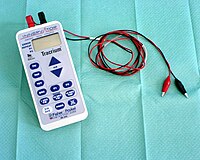
Photo from wikipedia
Even small degrees of residual neuromuscular blockade, i. e. a train-of-four (TOF) ratio >0.6, may lead to clinically relevant consequences for the patient. Especially upper airway integrity and the ability to swallow… Click to show full abstract
Even small degrees of residual neuromuscular blockade, i. e. a train-of-four (TOF) ratio >0.6, may lead to clinically relevant consequences for the patient. Especially upper airway integrity and the ability to swallow may still be markedly impaired. Moreover, increasing evidence suggests that residual neuromuscular blockade may affect postoperative outcome of patients. The incidence of these small degrees of residual blockade is relatively high and may persist for more than 90 min after a single intubating dose of an intermediately acting neuromuscular blocking agent, such as rocuronium and atracurium. Both neuromuscular monitoring and pharmacological reversal are key elements for the prevention of postoperative residual blockade.
Journal Title: Der Anaesthesist
Year Published: 2017
Link to full text (if available)
Share on Social Media: Sign Up to like & get
recommendations!